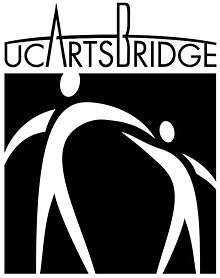ArtsBridge
ArtsBridge is a university scholarship program in the United States created by Lawrence University president Jill Beck in April 1996 when she was dean of the Claire Trevor School of the Arts at the University of California, Irvine. She brought together groups of local elementary pupils to receive arts training from UCI arts majors.[1] It was designed to attract public and private funding to support scholarships for top arts graduate and undergraduate students who commit themselves to teaching their speciality to one or more classes of K-12 pupils in local schools.[2]
Reason for creation
The program was a response to two perceived needs: (1) to provide financial aid to university students and (2) to help primary and secondary schools whose arts budgets had been wiped out by several economic downturns in California, including the passage in 1978 of Proposition 13 [3] which restricted property taxes to such an extent that educational commitments to

the state's children could not be met. "ArtsBridge Scholars" aimed to fill in the arts gap by partnering with classroom teachers and teaching dance, drama, music or studio arts directly to pupils, requiring no payment from the schools' budgets and often providing the classes with musical instruments, cameras, and other physical accessories necessary to each art.
The Original Program
UCI drama professor Keith Fowler served as the original director of ArtsBridge.[4] Aware that hundreds of new Scholars were still not enough to fill arts needs uniformly for so many schools, Fowler built relationships with those schools who signed on to a four-year plan stating that every pupil would progress from a year in studio art, to music, then dance, and finally drama.[5] The purpose of the plan was not only to guarantee arts on a consistent basis but to help research scholars by providing pupil subjects with stable exposure to the arts. In 1998, with the encouragement of then California Secretary of Education, Marian Bergeson, the state legislature granted funding to spread the ArtsBridge program to eight campuses of the University of California.[6] The various campuses modeled their programs initially on Fowler's documentation, including the master manual, begun in 1997 and updated through 2001, Bridging the Gap.[7] Fowler resigned his post in 2003.[8]
Success story
Throughout America, local school districts have responded to funding crises by drastic cutting of arts programs, ignoring clear evidence that regular exposure to the arts significantly enhances learning as shown in SAT scores in mathematics, science, and other "traditional" academics.[9] ArtsBridge is an educational success story, its importance attested to by conference proceedings and internal studies [10] as well as independent papers by experts like Maureen Burns.[11] It is one of the few programs helping to maintain or restore the arts to American school children. It has gained support from such private sources as the Dana Foundation [12] and from local government programs, and has grown into a supra-national network, "ArtsBridge America," of thirty-one universities in sixteen states and Northern Ireland.[13] Beck remains active as its national director, with an immediate support staff of Liane Brouillete and Jasmine Yep.[14]

K-12 administrators, educators, principals, and classroom teachers who seek arts education for their pupils, either to supplement an existing program or to bring art, dance, music, or drama to their classes for the first time may consult the list of ArtsBridge America sites to find an chapter nearest them [15] and make application. Here are the sites listed [16] for ArtsBridge America in 2012, but not all may be accepting applications:
List
- Appalachian State University
- Arizona State University
- ArtsBridge America National Office
- Brigham Young University
- California State University, Long Beach
- California State University, Sacramento
- Lawrence University ArtsBridge
- Michigan State University
- Milwaukee Institute of Art & Design
- Oklahoma State University – Tulsa
- Purchase College, State University of New York
- Southern Utah University
- University of Arizona
- University of California, Berkeley
- University of California, Davis
- University of California, Irvine
- University of California, Santa Barbara
- University of California, Los Angeles (School of Arts and Architecture)
- University of California, Los Angeles (School of Theater, Film and Television)
- University of California, San Diego
- University of California, Santa Cruz
- University of Central Florida
- University of Colorado at Boulder
- University of Delaware
- University of Hawaii, Manoa
- University of Montana – Missoula
- University of Nevada, Las Vegas
- University of Oregon
- University of Ulster, Northern Ireland
- University of Utah
- University of Wisconsin-Madison
- Utah State University
References
- ↑ Haycox, Lori, "Building an Arts Bridge to Area Schools", Los Angeles Times, November 20, 1996. Retrieved 2012-02-27.
- ↑ Perera, Andrea, "Bridging the Artistic Gap for Students and Teachers", Los Angeles Times, February 06, 2002. Retrieved 2012-02-27.
- ↑ http://www.leginfo.ca.gov/.const/.article_13A
- ↑ Brandt, Lori, "State of the arts," Today@UCI, 08/29/2002, "Archived copy". Archived from the original on 2012-01-14. Retrieved 2012-02-27.
- ↑ Fowler, K. "How Much Art and How Often?" Learning through the Arts,, 2002,http://escholarship.org/uc/item/7tn7c4vh?query=keith%20fowler
- ↑ http://www.artsbridgeamerica.com/docs/AnnRpt01.pdf[]
- ↑ http://escholarship.org/uc/item/86m657p8. (Fifth edition, September 2001)
- ↑ Succeeded on the original campus by Ana Halland, Claire Trevor director of Outreach
- ↑ "Art Students outperform non-arts peers on the SAT," shown in chart, at http://escholarship.org/uc/item/7tn7c4vh?query=How%20Much%20art#page-5
- ↑ http://www.artsbridgeamerica.com/publications.php[]
- ↑ Burns, Maureen Anne (2002). ArtsBridge: An exploration of collaborative outreach in the arts. ISBN 978-0-493-77157-1.
- ↑ See The Dana Foundation Annual Reports, 1998–2008, Lists of Grant Recipients, http://www.dana.org/news/publications/publication.aspx?id=6408
- ↑ http://www.artsbridgeamerica.com/home.php[]
- ↑ http://www.artsbridgeamerica.com/whoswho.php[]
- ↑ http://www.artsbridgeamerica.com/artsbridgesites.php[]
- ↑ See also http://www.artsbridgeamerica.com/participatingcampuses.php.
